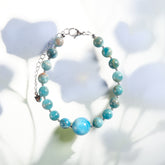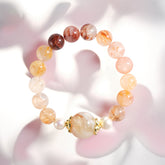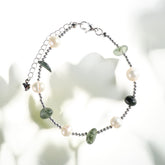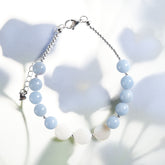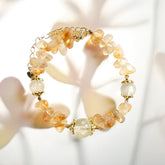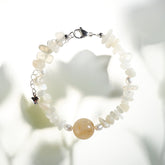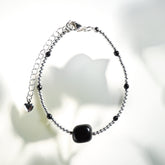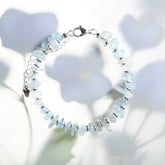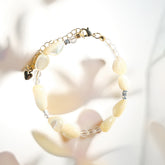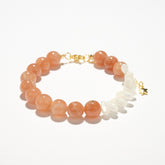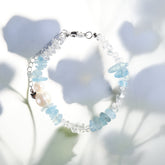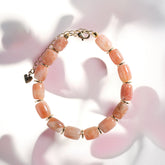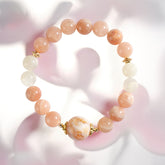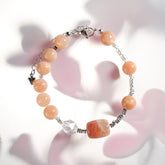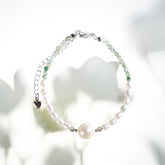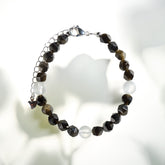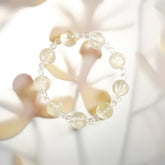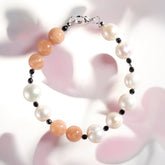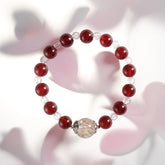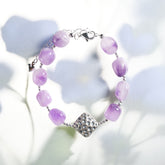Introduction of Amethyst
1. The characteristics of amethyst
1.1 Chemical composition and formation
Amethyst is essentially silicon dioxide (SiO₂) crystals, its charming purple color comes from iron (Fe), manganese (Mn) and other trace elements. Under specific geological conditions, silica-rich hydrothermal fluid in rock cavities or crevices slowly crystallize, the process of trace elements into it, giving amethyst a unique color. In Uruguay, for example, the local special geological environment has produced amethysts with rich and saturated colors and pure crystals, which are highly sought after by gemstone enthusiasts and have made people curious about the uniqueness of Uruguayan amethysts.
1.2 Physical Properties
(1)Hardness: Amethyst hardness is 7, in the Mohs hardness scale in the medium hard level, with good wear resistance, suitable for daily wear.
(2)Crystal form: a tripartite crystal system hexagonal prism shape, the column surface distribution of the unique horizontal lines, like nature engraved marks.
(3)Color and Transparency: The color ranges from light and soft lavender purple to rich and deep deep purple, with rich layers. Good quality amethysts are clear, with very few inclusions, and are crystal clear when exposed to light. Because of this, people often want to know how to identify the quality of amethyst by its color and transparencyin order to select the amethyst of their choice.
2. Amethyst in medicine
2.1 Traditional Healing Perceptions
In the field of alternative medicine, amethyst has long been recognized as a gemstone with powerful healing powers. As far back as the ancient Greek and Roman periods, it was believed that amethyst was able to ward off drunkenness and help the gods keep their sanity. From the perspective of Traditional Chinese Medicine (TCM), amethyst, also known as amethyst quartz, is believed to enter the kidney, heart and lung meridians, and is known to have calming, tranquilizing, lung-warming and uterine-warming properties. It can be used to improve symptoms such as insomnia and dreaminess, panic attacks, coughing in the lungs, as well as infertility in women with uterine cold, which sparked interest in exploring the medicinal value of amethyst in TCM.
2.2 Modern Application Conjectures
Modern practitioners of alternative medicine believe that amethyst may also have the ability to enhance the immune system and improve endocrine function. In the fast-paced modern life, many people treat amethyst as a "natural tranquilizer" in the hope that it can soothe irritability and help people find inner peace amidst the hustle and bustle, although these views have not yet been fully confirmed by science.

3. Amethyst grading standards in the jewelry industry
3.1 Grading elements
In the jewelry industry, the quality and value of amethyst is mainly based on the following four elements of grading.
(1) color: the ideal amethyst color is rich and uniform, slightly with red or blue tones is even better.
(2) Clarity: the fewer the internal inclusions and flaws, the higher the grade of the amethyst and the higher the value accordingly.
(3) Cutting: Superb cutting can subtly reflect and refract light inside the crystal, maximizing the luster and fire of the amethyst.
(4) carat weight: the greater the carat weight of the amethyst, because of its rarity, often worth a lot.
3.2 Example grading
Taking the amethyst produced in Arizona as an example, it is locally categorized into three grades.
Top: production is rare, only accounted for less than 10% of the mining volume, the color is deep and unique, more than 3 carats is extremely rare, usually used in high-end jewelry design, set in gold or platinum and other precious metals.
Premium: Slightly lighter in color, not as rare as Premium, but still vibrant and of better quality than most marketed products.
Ordinary: unstable color, spanning from dark to light, suitable for cost-effective or as a gift. Many collection enthusiasts and jewelry practitioners, are very concerned about the details of amethyst grading in Arizona.
4. Spiritual Significance and Cultural Connotation of Amethyst
4.1 cultural symbols
In different cultures, amethyst carries deep symbolism.
(1) Christianity: it represents the blood of Jesus, symbolizing piety and nobility.
(2) Buddhism: closely associated with spiritual practice, it is believed to help people achieve inner peace and enhance wisdom.
(3) Ancient Egypt: Used to decorate the tombs of pharaohs, symbolizing eternity and mystery.
4.2 Spiritual Associations
(1) Chakras: Mainly associated with the Brow Chakra and the Top Chakra. The brow chakra is responsible for intuition and insight, and wearing amethyst is said to enhance spiritual perception; the top chakra is connected to divine wisdom, and the energy of amethyst can purify distractions and facilitate spiritual awakening.
(2) Astrological Signs: In astrological culture, amethyst is a wonderful match for Aquarius. Aquarius is full of innovative spirit and free will, amethyst contains wisdom and peace, as well as strong intuition and protective energy, just echo the qualities of Aquarius, become a precious gemstone to guard their inspiration and rationality, but also make people keen to explore amethyst and Aquarius fit.
5. Amethyst Feng Shui effects
5.1 Gathering Qi and Prosperity
In feng shui culture, amethyst is given the function of gathering qi and promoting wealth. It is believed that placing it in the wealth position of your home or office can attract and condense positive energy, enhance the aura of the space, and bring a positive impact on your career and wealth.
5.2 Sleeping aid and tranquility
Placing amethyst in the bedroom, its soft energy soothes fatigue and creates a calm and peaceful atmosphere, relieving stress and improving sleep quality.
5.3 Stimulates Wisdom & Improves Relationships
Amethyst is also believed to stimulate wisdom and creativity, helping creative workers to open their minds; at the same time, it helps to improve interpersonal relationships, making people more peaceful and tolerant, and reducing friction and conflict in interpersonal interactions. Therefore, people often pay attention to the feng shui effects and placement of amethyst in their homes and offices, expecting to use its power to create a beautiful living and working environment.

6. Amethyst origin distribution and market trends
6.1 Origin
The origin of amethyst is all over the world.
(1) Brazil: the largest producer of amethyst, the output of amethyst quality is diverse, Minas Gerais deep purple amethyst is particularly famous.
(2) Uruguay: amethyst is known for its rich and deep color and high crystal quality, which is loved by collectors.
Other origins: Russia, Zambia, Madagascar and other countries are also rich in amethyst resources, amethyst from various origins due to differences in geological conditions, showing a distinctive appearance and quality.
6.2 Market Trends
In recent years, with the improvement of people's living standards and growing interest in natural gemstones, amethyst has shown the following trends in the global market.
(1) Rising demand: consumers are no longer only concerned about its beauty, but also pay more attention to the cultural and spiritual connotations behind amethyst.
(2) Price changes: the price of high-quality amethyst continues to rise, especially those rare large particles or special color varieties.
(3) Design innovation: amethyst jewelry design continues to innovate and integrate modern fashion elements to meet the aesthetic needs of different consumers, which also triggered an in-depth reflection on the reasons for the growth of demand for amethyst market.
Amethyst, the purple gemstone from nature, with its unique characteristics, rich uses and deep cultural connotations, has blossomed in many areas of human life, and is worthy of our continuous in-depth exploration and appreciation.
Recommended Products





















